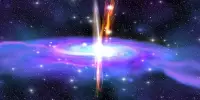GRB 130427A shone brighter than any other gamma-ray explosion known to science. It emitted a massive quantity of energy in the form of gamma rays, the most energetic type of electromagnetic radiation. Because of its extraordinary brilliance, it stood out in the sky. GRB 130427A was relatively close to Earth, at a distance of around 3.6 billion light-years, in contrast to most gamma-ray bursts, which are normally observed at cosmological distances. Because of its close vicinity, astronomers were able to study it in unprecedented depth.
Few cosmic explosions have piqued the interest of space scientists as much as the one recorded on October 22 of last year and rightly termed the Brightest of All Time (BOAT). The event was viewed as an extremely intense flash of gamma rays followed by a slow-fading afterglow of light spanning frequencies, caused by the implosion of a huge star and the subsequent formation of a black hole.
Since simultaneously detecting the BOAT signal with their massive telescopes, astrophysicists all over the world have been trying to explain the brilliance of the gamma-ray burst (GRB) and the strangely sluggish fade of its afterglow.
Our work clearly shows that the GRB had a unique structure, with observations gradually revealing a narrow jet embedded within a wider gas outflow where an isolated jet would normally be expected.
Dr Van Eerten
Now, an international team led by Dr. Hendrik Van Eerten of the Department of Physics at the University of Bath in the United Kingdom has proposed an explanation: the initial burst (known as GRB 221009A) was angled directly at Earth and dragged an unusually large amount of stellar material in its wake.
The findings of the researchers were published today in the journal Science Advances. The study’s principal author is Dr. Brendan O’Connor, a recently graduated Ph.D. student at the University of Maryland and George Washington University in Washington, DC.
Dr. Van Eerten, who co-led the theoretical analysis of the afterglow, said: “Other researchers working on this puzzle have also come to the conclusion that the jet was pointed directly at us — much like a garden hose angled to spray straight at you — and this definitely goes some way to explain why it was seen so brightly.
But what remained a puzzle was that the edges of the jet could not be seen at all.

“The slow fade of the afterglow is not characteristic of a narrow jet of gas, and knowing this made us suspect there was an additional reason for the intensity of the explosion, and our mathematical models have borne this out. Our work clearly shows that the GRB had a unique structure, with observations gradually revealing a narrow jet embedded within a wider gas outflow where an isolated jet would normally be expected.”
So, what caused this GRB to be broader than usual? The researchers have a hypothesis. “GRB jets need to go through the collapsing star in which they are formed,” Dr. Van Eerten explained, “and what we think made the difference in this case was the amount of mixing that happened between the stellar material and the jet, such that shock-heated gas kept appearing in our line of sight all the way up to the point where any characteristic jet signature would have been lost in the overall emission from the afterglow.”
“Our model helps not only to understand the BOAT, but also previous brightness record holders who had astronomers perplexed due to their lack of jet signature,” he noted. These GRBs, like all GRBs, must be directed directly towards us when they occur since it is physically impossible for that much energy to be ejected in all directions at once. There appears to be an uncommon class of events that are both intense and manage to conceal the directed nature of their gas flow. Future research into the magnetic fields that propel the jets, as well as the enormous stars that host them, should help explain why GRBs are so rare.”
“The exceptionally long GRB 221009A is the brightest GRB ever recorded, and its afterglow is smashing all records at all wavelengths,” said Dr. O’Connor. Because this burst is so bright and so close (cosmically speaking, it occurred at a minor distance of 2.4 billion light-years from Earth), we believe it is a once-in-a-thousand-year opportunity to address some of the most fundamental questions about these explosions, from black hole formation to dark matter model tests.”
















